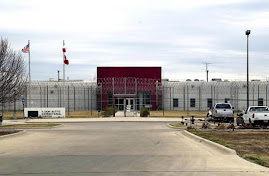
After months of requests, several local LULAC representatives, were allowed into Hutto on April 4th for an official tour. The tour was led by officials from ICE and Corrections Company of America, a for-profit prison management corporation which operates the facility.
By Philip Jankowski. Full article available at Taylor Daily Press.
Immigrants detained in the T. Don Hutto Residential Facility are mostly women and children, according to Jose Orta, who recently toured the facility.
The facility has two wings - a family unit for both men and women, and a women's unit, Orta said.
“I was struck with how large it is. There were these two large hallways - all beige with highly polished concrete floors,” Orta said. “It was sort of eerie, it gave the taste of an institution.”
A common misconception is that all residents of the facility are Mexican nationals, Orta said. Actually, out of the 296 residents, only 10 are from Mexico, according to information provided by ICE.
Most immigrants housed in the facility are from Central and South America, with a majority from Honduras, Guatemala and El Salvador. There are also immigrants from China, Poland, India and Burma.
“It's virtually a United Nations,” Orta said.
The government of Honduras disagrees with the federal government's classification of its immigrants as criminals, Wendy Rivera, an official from the Honduran Embassy in Washington, D.C., said.
All inmates are being held while deportation proceedings take place on no other criminal charges besides entering the U.S. illegally - a class C misdemeanor.
Orta said CCA has done away with uniforms resembling prison jump suits or scrubs for immigrants. Now, residents can wear their own clothing, provided it is appropriate for the facility. Otherwise, detainees are provided with jeans and T-shirts, he said.
The family unit houses 66 children, Orta said. Parents and children are not separated, however married couples are not allowed to share a room. According to Orta, officials said couples are not allowed to display affection toward each other.
And from Eye on Williamson, some of Taylor resident Jose Orta's reactions to his visit to Hutto. I encourage everyone to consult the full article. Below are just excerpts..
On Friday, April 4, 2008, I and four others; Rosa Rosales, Elvia Mendoza, Rita Gonzales-Garza and Marcelo Tafoya, were granted access to the CCA/T. Don Hutto Facility. We were given a tour of T. Don Hutto by Evelyn Hernandez, the facility administrator of T. Don Hutto/CCA, George Robertson and Patricia Barbra from ICE.
We were repeatedly told that the infrastructure “is what it is”. The retrofit of the prison includes murals painted in the pods, the razor wire being taken down and the crash gate in the front entrance being dismantled. Mr. Robertson was especially proud of the fact that T. Don Hutto went “well beyond the National Detention Model”.
Seeing the facility from the outside confined to Welch Street pales in comparison with actually entering the facility and seeing it from the inside. I was struck by how large the facility actually is on the inside. T. Don Hutto has a stark, cold institutional prison-like feel. It may be labeled a residential facility, but movement seems to be heavily controlled. Most doors are locked. You must have access codes to obtain entry. All have Hall Monitors/Guards on staff as well as cameras to monitor movement in the hallways.
T. Don Hutto has at least 4 large cavernous beige colored hallways that must be used to access any of the spaces. You can hear the echo of your steps and see your reflection as you walk along the highly varnished concrete floors. The protruding exposed piping and conduits in the ceilings also gives off an industrial feel.
Our tour consisted of the following spaces at T. Don Hutto: the library, the computer lab, a family pod, a women only pod, the visitation area, the cafeteria, a mental health office, the medical office, the gym, the playground, the education portables and the intake/processing room. We were carefully monitored so that we would have very little contact with the detainees.
Most of the detainees that I had a chance to see while peering into closed doors or away from the tour seem oblivious to our presence. Many had blank stares. It was almost as if these women were making the best of the situation at hand. While touring the Women’s Pod, most of the women seemed to be centrally situated in the center of the pod where one TV had Rubi showing. Out of the corner of my eye, I spotted one female that was crouched under the pod stairwell – sitting apart from the rest. I didn’t have the foresight to ask why this was so. I saw another woman whose dark piercing eyes seemed filled with sadness.








